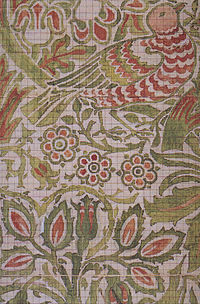Textile design, also known as textile geometry, is the creative and technical process by which thread or yarn fibers are interlaced to form a piece of cloth or fabric, which is subsequently printed upon or otherwise adorned.[1] Textile design is further broken down into three major disciplines: printed textile design, woven textile design, and mixed media textile design. Each uses different methods to produce a fabric for variable uses and markets. Textile design as an industry is involved in other disciplines such as fashion, interior design, and fine arts.[2][3]

- ^ Clarke, Simon (2011). "Introduction". Textile Design. London [England]: Laurence King. ISBN 978-1-78539-200-9. OCLC 908338301.
- ^ Briggs-Goode, A. (Amanda). "Introduction". Printed textile design. London. ISBN 978-1-78067-403-2. OCLC 898176484.
- ^ Russell, Alex (2016). "Introduction". The Fundamentals of Printed Textile Design. [London]: Bloomsbury. ISBN 978-1-4742-1853-5. OCLC 1053941237.